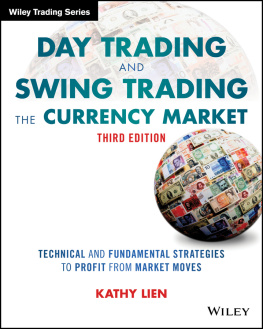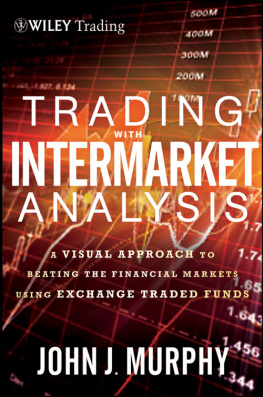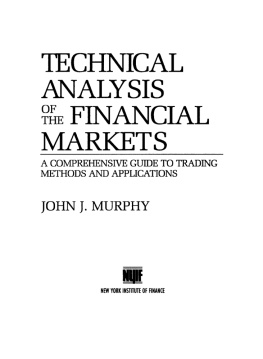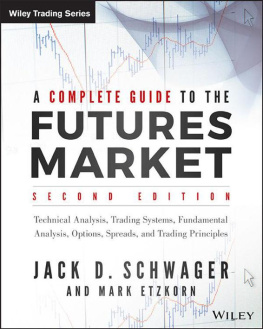Founded in 1807, John Wiley & Sons is the oldest independent publishing company in the United States. With offices in North America, Europe, Australia, and Asia, Wiley is globally committed to developing and marketing print and electronic products and services for our customers' professional and personal knowledge and understanding.
The Wiley Trading series features books by traders who have survived the market's ever changing temperament and have prosperedsome by reinventing systems, others by getting back to basics. Whether a novice trader, professional, or somewhere in-between, these books will provide the advice and strategies needed to prosper today and well into the future.
For a list of available titles, visit our website at www.WileyFinance.com .
Cover image: iStockphoto.com/ULTRA_GENERIC
Cover design: Wiley
Copyright 2013 by James F. Dalton, Eric T. Jones, and Robert B. Dalton. All rights reserved.
Published by John Wiley & Sons, Inc., Hoboken, New Jersey.
The first edition was published in 1993 by Traders Press, Inc.
Published simultaneously in Canada.
No part of this publication may be reproduced, stored in a retrieval system, or transmitted in any form or by any means, electronic, mechanical, photocopying, recording, scanning, or otherwise, except as permitted under Section 107 or 108 of the 1976 United States Copyright Act, without either the prior written permission of the Publisher, or authorization through payment of the appropriate per-copy fee to the Copyright Clearance Center, Inc., 222 Rosewood Drive, Danvers, MA 01923, (978) 7508400, fax (978) 6468600, or on the Web at www.copyright.com . Requests to the Publisher for permission should be addressed to the Permissions Department, John Wiley & Sons, Inc., 111 River Street, Hoboken, NJ 07030, (201) 7486011, fax (201) 7486008, or online at www.wiley.com/go/permissions .
Limit of Liability/Disclaimer of Warranty: While the publisher and author have used their best efforts in preparing this book, they make no representations or warranties with respect to the accuracy or completeness of the contents of this book and specifically disclaim any implied warranties of merchantability or fitness for a particular purpose. No warranty may be created or extended by sales representatives or written sales materials. The advice and strategies contained herein may not be suitable for your situation. You should consult with a professional where appropriate. Neither the publisher nor author shall be liable for any loss of profit or any other commercial damages, including but not limited to special, incidental, consequential, or other damages.
For general information on our other products and services or for technical support, please contact our Customer Care Department within the United States at (800) 7622974, outside the United States at (317) 5723993, or fax (317) 5724002.
Wiley publishes in a variety of print and electronic formats and by print-on-demand. Some material included with standard print versions of this book may not be included in e-books or in print-on-demand. If this book refers to media such as a CD or DVD that is not included in the version you purchased, you may download this material at http://booksupport.wiley.com . For more information about Wiley products, visit www.wiley.com .
Library of Congress Cataloging-in-Publication Data
Dalton, James F.
Mind over markets: power trading with market generated information/James F. Dalton, Eric T. Jones & Robert B. Dalton. 2nd Edition.
pages cm. (Wiley trading series)
Includes index.
ISBN 978-1-11853173-0 (cloth) ISBN 978-1-11865978-6 (ePDF) ISBN 978-1-11865972-4 (Mobi) ISBN 978-1-11865976-2 (ePub)
1. Futures. I. Jones, Eric T. (Eric Thomas) II. Dalton, Robert B. III. Title.
HG6024.A3D35 2013
332.645dc22
2013004403
Preface
When Mind Over Markets was first published in 1990, the Market Profile was relatively new. I was fascinated by the utility because it provided a new way to structure information, a new way to look at the market through a time-sensitive, evolving database that records the market's continuous two-way auction process.
I had long been skeptical about analysis that treated all prices as equal. After years studying market behaviorwith membership on the Chicago Board of Trade and as a founding member of the Chicago Board Options ExchangeI came to the conclusion that fundamental analysis is generally too long term, often appearing out of touch with the market. Auction market theory, on the other hand, seemed to offer the most objective means of allocating the constant flow of bids and offers.
I embraced the idea that auctions are mechanisms for price discovery .
Mind Over Markets is a practical handbook for developing an understanding of market behavior that will help you trade with the odds in your favor. And in the 20 years since it was first published (and translated into Chinese and French), my co-authors and I have continued to delve deeper into the application of auction theory to trading and investment decisions.
In the first printing, we talked about buying and selling tails in Profile structure. We'll get into the mechanics of this concept later in the book, but we mention them here, in this new introduction, because they represent an example of how our understanding has evolved since the original publication, thanks to the best teacher of all: experience . We still believe in the structural significance of tails, but we have developed a more nuanced appreciation for what causes tails, or more tellingly, what causes the lack of a tail (an indication that the market has gotten too long or too short).
This understandinglike all understandingevolved over time. It is the context surrounding the indicator that signals a deeper layer of meaning. Factors like volume and tempo provide clues about which timeframe is leading market movement. And as you'll discover, discerning timeframe influence is one of the most important insights you can develop as an agile-brained trader.
Does the Profile Still Work, after All These Years?
I'm often asked if the Profile works. Or, more commonly, if it still works. The better question is this: Is the Market Profile a valid scientific way to organize data?
The answer to that question is a definite yes. The Profile is constructed using a constant time on the horizontal axis, and a variable price on the vertical axis to form a distribution. Scientists have employed this method to study and observe data for generations. Personally, I would much rather study organized data than unorganized data; the Profile is simply a valuable tool for organizing objective information.
After a lifetime spent observing markets, I choose to give more emphasis to the Market Profilewith its evolving, multidimensional structurebecause I believe it provides a more accurate representation of the auction process, as it unfolds . It smooths out aberrations, such as high volume at the opening bell, as well as statistical references like the overnight high and low that can mislead you in the heat of the moment.
To be clear, I'm a trader, not a Profile trader. However, the Profile has been invaluable to my analysis, and it has enabled my personal evolution through decades of reading and interpreting data in its ever-changing visualizations. Over time, my knowledge has deepened through practiceand not just practice, but correct practice. Choose any sport and you'll recognize the importance of practicing a correct stroke/shot/swing; practice wrong and you'll cement bad habits that can take years to unlearn.
One of the most astute Amazon.com reviews for this book was not intended as a complimentthe reviewer said Mind over Markets is too complicated. Those two words capture the reason why most traders fail, as well as the reason why the book in your hands is still relevant, challenging, and insightful after two decades: It was written for serious traders, and it doesn't purport to be a total solution.
Next page








